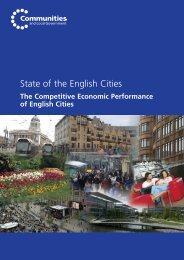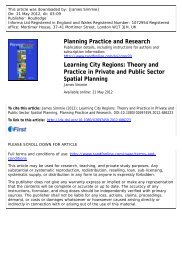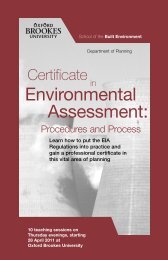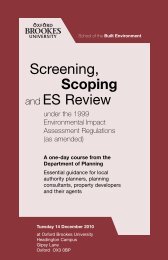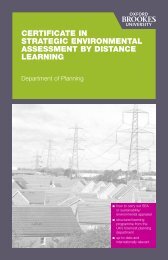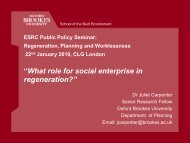History Matters: Path dependence and innovation in British city ...
History Matters: Path dependence and innovation in British city ...
History Matters: Path dependence and innovation in British city ...
Create successful ePaper yourself
Turn your PDF publications into a flip-book with our unique Google optimized e-Paper software.
Part 3: Cambridge <strong>and</strong> Swansea: contrast<strong>in</strong>g path<br />
dependent economies<br />
3.1 A Tale of Two Cities<br />
In this chapter we turn our focus from a multi<strong>city</strong><br />
statistical discussion to a more detailed<br />
exam<strong>in</strong>ation of two particular case-study cities<br />
selected on the basis of their very different<br />
experiences – Cambridge <strong>and</strong> Swansea. The<br />
former, as our analysis of CIS data showed,<br />
has been one of the best perform<strong>in</strong>g <strong>British</strong><br />
cities for <strong>in</strong>novative activity; <strong>in</strong>deed it regularly<br />
ranks as one of the most <strong>in</strong>novative places<br />
<strong>in</strong> Europe. Swansea, on the other h<strong>and</strong>, has<br />
been one of the worst perform<strong>in</strong>g cities, with<br />
a very low rate of <strong><strong>in</strong>novation</strong>. The value of this<br />
‘contrastive case-study’ methodology is that<br />
it helps to reveal how locally-specific path<br />
<strong>dependence</strong> processes <strong>and</strong> histories condition<br />
local <strong><strong>in</strong>novation</strong> outcomes <strong>and</strong> developments<br />
– either positively (as <strong>in</strong> Cambridge) or<br />
negatively (as <strong>in</strong> Swansea). As our discussion<br />
below reveals, the two cities have followed<br />
very different development paths over the last<br />
three decades, produc<strong>in</strong>g different <strong>and</strong> selfre<strong>in</strong>forc<strong>in</strong>g<br />
<strong><strong>in</strong>novation</strong> trajectories.<br />
3.2 <strong>Path</strong> dependent development<br />
The theoretical model outl<strong>in</strong>ed <strong>in</strong> Part 1 posits<br />
that the ma<strong>in</strong> sectoral development pathways<br />
that emerge over time with<strong>in</strong> a <strong>city</strong>-region<br />
economy collectively determ<strong>in</strong>e its relative<br />
capa<strong>city</strong> (more precisely, of course, the<br />
capacities of its firms, workers <strong>and</strong> <strong>in</strong>stitutions)<br />
both to create new knowledge <strong>in</strong>digenously<br />
<strong>and</strong> to absorb new knowledge from external<br />
sources, <strong>and</strong> thereby to shape its propensity<br />
to <strong>in</strong>novate. <strong>History</strong> – or place-specific<br />
history – matters. The past development of<br />
a local economy <strong>and</strong> its legacy condition the<br />
scope <strong>and</strong> opportunities for new pathways<br />
of technological <strong>and</strong> <strong>in</strong>dustrial development.<br />
Cambridge <strong>and</strong> Swansea illustrate this process<br />
<strong>in</strong> significant ways: the two cities have had<br />
quite different economic histories (see Table<br />
1), <strong>and</strong> their quite disparate <strong>in</strong>novative<br />
performances over recent decades have<br />
reflected these differences.<br />
Swansea: the legacy of an old <strong>in</strong>dustrial<br />
past<br />
Swansea has seen three ma<strong>in</strong> phases <strong>in</strong> its<br />
development. Historically, the <strong>city</strong> was heavily<br />
dependent on extractive <strong>in</strong>dustries <strong>and</strong> the<br />
production of coal, iron, copper, t<strong>in</strong> <strong>and</strong> z<strong>in</strong>c,<br />
earn<strong>in</strong>g it the moniker ‘Copperopolis’ <strong>in</strong> the<br />
19th century, when at its peak, Swansea was<br />
produc<strong>in</strong>g 60 per cent of the world’s copper<br />
requirements. However, by the 1960s <strong>and</strong> 70s,<br />
many of these heavy <strong>in</strong>dustries had closed,<br />
with the last local coal m<strong>in</strong>e clos<strong>in</strong>g <strong>in</strong> the early<br />
1980s.<br />
The second phase of development was<br />
triggered by the decl<strong>in</strong>e of these <strong>in</strong>dustries.<br />
Attracted partly by the pool of low-skilled lowwage<br />
labour released by de<strong>in</strong>dustrialisation,<br />
mult<strong>in</strong>ational companies identified South Wales<br />
as a location for their assembly branch plants.<br />
One of the first significant <strong>in</strong>ward <strong>in</strong>vestments<br />
<strong>in</strong> the electronics <strong>in</strong>dustry was the Sony facility<br />
<strong>in</strong> Bridgend <strong>in</strong> 1973, east of Swansea. This<br />
was the first major Japanese <strong>in</strong>vestment <strong>in</strong><br />
Wales, <strong>and</strong> acted as a catalyst for other <strong>in</strong>ward<br />
<strong>in</strong>vestors, particularly <strong>in</strong> the electronics sector.<br />
At the height of production, 50 per cent of<br />
televisions <strong>and</strong> 75 per cent of video cassette<br />
recorders (VCRs) produced <strong>in</strong> Europe were<br />
made <strong>in</strong> Wales. These markets have both now<br />
effectively disappeared with technological<br />
change.<br />
36





